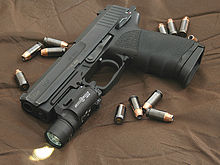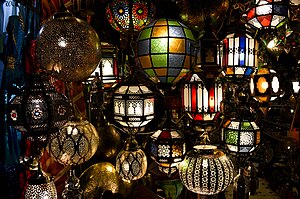
A rechargeable battery, storage battery, or secondary cell, is a type of electrical battery which can be charged, discharged into a load, and recharged many times, as opposed to a disposable or primary battery, which is supplied fully charged and discarded after use. It is composed of one or more electrochemical cells. The term "accumulator" is used as it accumulates and stores energy through a reversible electrochemical reaction. Rechargeable batteries are produced in many different shapes and sizes, ranging from button cells to megawatt systems connected to stabilize an electrical distribution network. Several different combinations of electrode materials and electrolytes are used, including lead–acid, zinc–air, nickel–cadmium (NiCd), nickel–metal hydride (NiMH), lithium-ion (Li-ion), lithium iron phosphate (LiFePO4), and lithium-ion polymer.

A flashlight or torch is a portable hand-held electric lamp. Formerly, the light source typically was a miniature incandescent light bulb, but these have been displaced by light-emitting diodes (LEDs) since the mid-2000s. A typical flashlight consists of the light source mounted in a reflector, a transparent cover to protect the light source and reflector, a battery, and a switch, all enclosed in a case.

Maglite is a brand of flashlight manufactured in the United States by Mag Instrument, Inc. located in Ontario, California, and founded by Anthony Maglica. It was introduced in 1979. Constructed principally of anodized 6061 aluminum, they have a variable-focus beam. Maglites are produced in several colors such as black, silver, blue, red, green, purple, gold, and different finishes. Originally Maglite flashlights used krypton or xenon incandescent bulbs. Current models have LEDs, although the older models are still widely available.
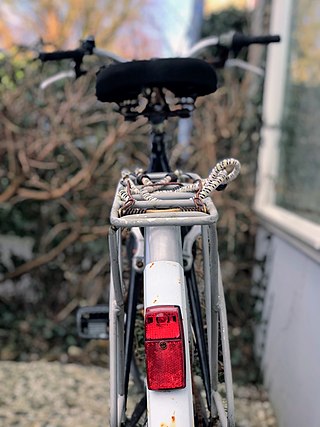
Bicycle lighting is illumination attached to bicycles whose purpose above all is, along with reflectors, to improve the visibility of the bicycle and its rider to other road users under circumstances of poor ambient illumination. A secondary purpose is to illuminate reflective materials such as cat's eyes and traffic signs. A third purpose may be to illuminate the roadway so that the rider can see the way ahead. Serving the latter purposes require much more luminous flux and thus more power.
A primary battery or primary cell is a battery that is designed to be used once and discarded, and not recharged with electricity and reused like a secondary cell. In general, the electrochemical reaction occurring in the cell is not reversible, rendering the cell unrechargeable. As a primary cell is used, chemical reactions in the battery use up the chemicals that generate the power; when they are gone, the battery stops producing electricity. In contrast, in a secondary cell, the reaction can be reversed by running a current into the cell with a battery charger to recharge it, regenerating the chemical reactants. Primary cells are made in a range of standard sizes to power small household appliances such as flashlights and portable radios.
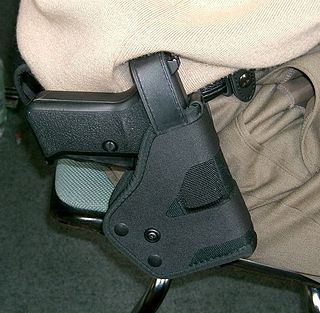
A handgun holster is a device used to hold or restrict the undesired movement of a handgun, most commonly in a location where it can be easily withdrawn for immediate use. Holsters are often attached to a belt or waistband, but they may be attached to other locations of the body. Holsters vary in the degree to which they secure or protect the firearm. Some holsters for law enforcement officers have a strap over the top of the holster to make the handgun less likely to fall out of the holster or harder for another person to grab the gun. Some holsters have a flap over the top to protect the gun from the elements.

The AA battery is a standard size single cell cylindrical dry battery. The IEC 60086 system calls the size R6, and ANSI C18 calls it 15. It is named UM-3 by JIS of Japan. Historically, it is known as D14, U12 – later U7, or HP7 in official documentation in the United Kingdom, or a pen cell.

SureFire, LLC. is an American company headquartered in Fountain Valley, California. Their main products are flashlights, weapon-mounted lights, headlamps, and laser sights. In addition, Surefire produces knives, sound suppressors, earplugs, Picatinny Rails, high capacity magazines, and batteries. The company is a major supplier of flashlights, weapon lights, and lasers to the U.S. Armed Forces and its allies, especially for elite special operations groups such as the Navy SEALs. Surefire products are widely used in the U.S. by law enforcement agencies and SWAT teams.

A mechanically powered flashlight is a flashlight that is powered by electricity generated by the muscle power of the user, so it does not need replacement of batteries, or recharging from an electrical source. There are several types which use different operating mechanisms. They use different motions to generate the required power; such as squeezing a handle, winding a crank, or shaking the flashlight itself. These flashlights can also be distinguished by the technique used to store the energy: a spring, a flywheel, a battery or a capacitor.

The AN/PEQ-6 Integrated Laser Light Module (ILLM) is a laser aiming module (LAM) designed and manufactured by Insight Technology for use by United States Special Operations Command (USSOCOM) with the Heckler & Koch Mark 23 semi-automatic pistol and a Knight's Armament Company suppressor; the whole system is designated the Mk 23 Mod 0 Offensive Handgun Weapon System.
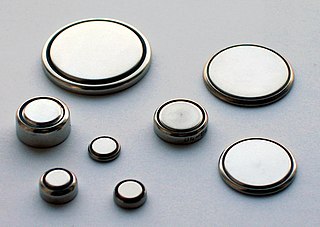
A button cell, watch battery, or coin battery is a small single-cell battery shaped as a squat cylinder typically 5 to 25 mm in diameter and 1 to 6 mm high — resembling a button. Stainless steel usually forms the bottom body and positive terminal of the cell; insulated from it, the metallic top cap forms the negative terminal.
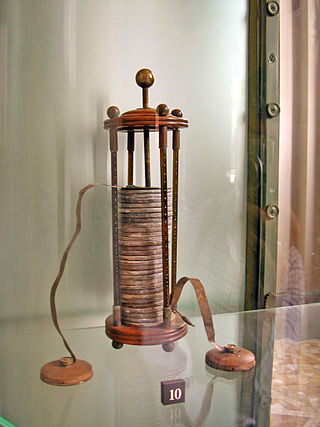
Batteries provided the primary source of electricity before the development of electric generators and electrical grids around the end of the 19th century. Successive improvements in battery technology facilitated major electrical advances, from early scientific studies to the rise of telegraphs and telephones, eventually leading to portable computers, mobile phones, electric cars, and many other electrical devices.

A police duty belt is a belt, typically constructed of nylon or leather used by police, prison and security officers to carry equipment easily in a series of pouches attached to the belt, in a readily-accessible manner, while leaving the hands free to interact. This belt can carry any number of useful items, ranging from handcuffs to guns.
Kel-Lite was the first heavy-duty aluminum bodied flashlight, which became popular with law enforcement agencies due to its heavy construction. They were designed to be carried in place of a police baton and also provide light. The eponymous company, founded by Donald Keller and Frank Patti in 1968, manufactured Kel-Lite flashlights in southern California until 1983, when the company was merged into Streamlight.
Streamlight is a company located in Eagleville, Pennsylvania, United States, that manufactures flashlights powered by various rechargeable and disposable batteries.

A headlamp, headlight, or head torch (UK) is a light source affixed to the head typically for outdoor activities at night or in dark conditions such as caving, orienteering, hiking, skiing, backpacking, camping, mountaineering or mountain biking. Headlamps may also be used in adventure races. Headlamps are often used by workers in underground mining, search and rescue, surgeons, and by other workers who need hands-free directed lighting.
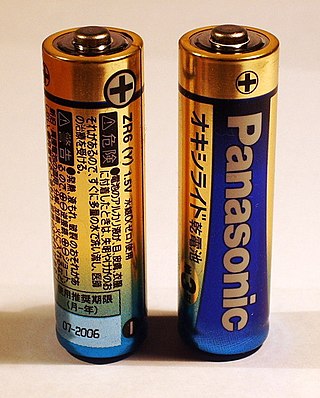
Nickel oxyhydroxide battery is a type of primary cell. It is not rechargeable and must be disposed after a single use. NiOx batteries can be used in high-drain applications such as digital cameras.

Solar powered flashlights or solar powered torches are flashlights powered by solar energy stored in rechargeable batteries. Most of these flashlights use light-emitting diodes lamps since they have lower energy consumption compared to incandescent light bulbs.

A dive light is a light source carried by an underwater diver to illuminate the underwater environment. Scuba divers generally carry self-contained lights, but surface supplied divers may carry lights powered by cable supply.

A laser sight is a device attached or integral to a firearm to aid target acquisition. Unlike optical and iron sights where the user looks through the device to aim at the target, laser sights project a beam onto the target, providing a visual reference point.



